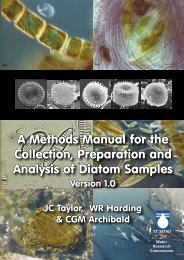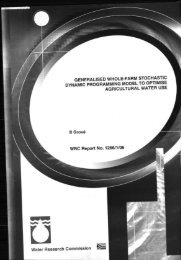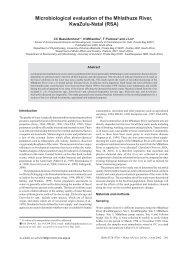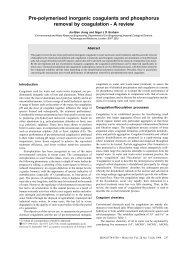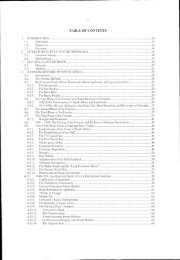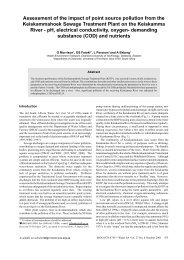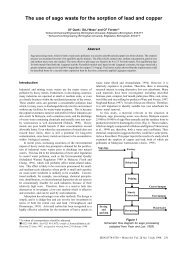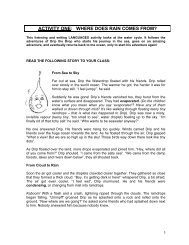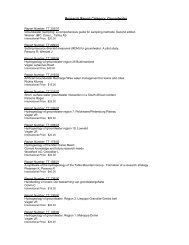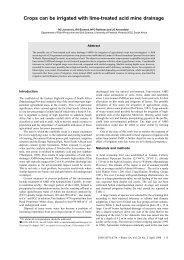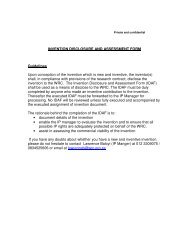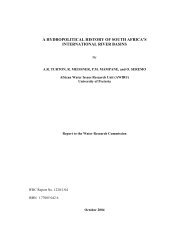and the Efficacy of Pit Latrine Additives - Water Research Commission
and the Efficacy of Pit Latrine Additives - Water Research Commission
and the Efficacy of Pit Latrine Additives - Water Research Commission
- No tags were found...
You also want an ePaper? Increase the reach of your titles
YUMPU automatically turns print PDFs into web optimized ePapers that Google loves.
4.4 Laboratory-scale testing <strong>of</strong> pit latrine additive products<br />
In <strong>the</strong> course <strong>of</strong> this project a number <strong>of</strong> hypo<strong>the</strong>ses have been proposed to describe <strong>the</strong> possible<br />
mechanism <strong>of</strong> pit latrine additives in reducing <strong>the</strong> volume or load <strong>of</strong> <strong>the</strong> contents in a pit latrine:<br />
a) under anaerobic conditions, a pit latrine additive might:<br />
increase <strong>the</strong> overall activity <strong>of</strong> micro-organisms <strong>and</strong> <strong>the</strong>reby conversion <strong>of</strong> solids to biogas<br />
increase <strong>the</strong> rate <strong>of</strong> <strong>the</strong> solubilisation step in digestion (through direct biological action or through<br />
enzyme activity), <strong>the</strong>reby converting slowly digestible solids to easily digestible (or drainable) liquid or<br />
liquid-soluble products<br />
have no significant effect<br />
b) Under aerobic conditions, a pit latrine additive might:<br />
<br />
<br />
Increase <strong>the</strong> overall activity <strong>of</strong> micro-organisms <strong>and</strong> <strong>the</strong>refore conversion <strong>of</strong> solids to biogas <strong>and</strong> new<br />
micro-organism mass<br />
Increase <strong>the</strong> rate <strong>of</strong> <strong>the</strong> solubilisation step (through direct biological action or through enzyme activity),<br />
<strong>the</strong>reby converting slowly digestible solids to easily digestible (or drainable) liquid or liquid-soluble<br />
products.<br />
Testing <strong>of</strong> pit latrine additives in <strong>the</strong> field was found to produce inconclusive results due to <strong>the</strong> difficulty <strong>of</strong><br />
obtaining representative measurements <strong>of</strong> any condition or property within <strong>the</strong> pit (Section 4.3.4.2), <strong>and</strong> <strong>the</strong><br />
lack <strong>of</strong> control <strong>of</strong> <strong>the</strong> test site. Fur<strong>the</strong>rmore, it was apparent that many <strong>of</strong> <strong>the</strong> observations drawn from field<br />
studies relate to <strong>the</strong> condition <strong>and</strong> ownership <strong>of</strong> <strong>the</strong> pit ra<strong>the</strong>r than <strong>the</strong> biological processes (or lack <strong>the</strong>re<strong>of</strong>)<br />
occurring within <strong>the</strong> pit.<br />
A fundamental conclusion <strong>of</strong> this research was that <strong>the</strong> efficacy <strong>of</strong> pit latrine additives cannot be satisfactorily<br />
measured in <strong>the</strong> field. It is necessary to have an independently managed, well controlled testing protocol<br />
through which an assessment <strong>of</strong> <strong>the</strong> effect <strong>of</strong> <strong>the</strong> additive on <strong>the</strong> pit latrine contents can be made.<br />
4.4.1 Protocols for testing pit latrine additives<br />
One output <strong>of</strong> this project was <strong>the</strong> development <strong>of</strong> a procedure for testing commercial pit latrine to measure<br />
<strong>the</strong> effectiveness <strong>of</strong> using <strong>the</strong>se products to control filling rates in a pit latrine. The aim <strong>of</strong> <strong>the</strong> protocols was<br />
to have a st<strong>and</strong>ard test for assessing how much additional degradation over <strong>and</strong> above natural degradation<br />
processes can be achieved by treating samples <strong>of</strong> pit latrine contents.<br />
4.4.1.1 Effect <strong>of</strong> sample source on trial outcomes<br />
An important feature <strong>of</strong> a laboratory test protocol is that <strong>the</strong>re should be a clearly identifiable relationship<br />
between what occurs in <strong>the</strong> test <strong>and</strong> what <strong>the</strong> equivalent effect in a pit latrine would be. The most obvious<br />
method <strong>of</strong> complying with this requirement was <strong>the</strong> use <strong>of</strong> samples <strong>of</strong> pit latrine contents as a test substrate<br />
for <strong>the</strong>se laboratory protocols. However, this approach has an immediately apparent drawback. It has been<br />
clearly shown that <strong>the</strong> contents <strong>of</strong> pit latrines show a large amount <strong>of</strong> variation in composition, <strong>and</strong> thus<br />
different pit latrine samples can be expected behave differently to one ano<strong>the</strong>r. Fur<strong>the</strong>r, given <strong>the</strong> particulate<br />
<strong>and</strong> heterogeneous nature <strong>of</strong> pit latrine material, it is not possible to homogenise <strong>the</strong> material to an extent<br />
that sub-samples <strong>of</strong> a mixed sample could be expected to give identical results in any testing protocol. No<br />
satisfactory method <strong>of</strong> overcoming this problem was found. However, <strong>the</strong> following points were kept in mind<br />
in <strong>the</strong> development <strong>of</strong> <strong>the</strong> testing protocols.<br />
<br />
<strong>Pit</strong> latrine additive products will only make direct contact with <strong>the</strong> material on <strong>the</strong> very top <strong>of</strong> <strong>the</strong> heap in<br />
a pit latrine; thus samples obtained for <strong>the</strong> purposes <strong>of</strong> testing pit latrine additives should be taken only<br />
from this uppermost layer.<br />
48



